
Should You Add Water to Acrylic Paint: What to Know
Whether you should add water to Acrylic paint or not depends on your artistic goals. Introducing water to acrylic paint is a common practice among artists. But it’s not always straightforward. The decision to add water to your acrylic paints can significantly impact your artwork’s outcome.

You might be a seasoned artist or just starting. However, understanding when and how to add water to acrylic paint is essential for achieving the desired effects in your creations.
Let’s explore the reasons behind adding water, the benefits it can bring to your acrylic painting process, and the precautions you should take to ensure your artistic vision comes to life.
Should You Add Water to Acrylic Paint?
Adding water to acrylic paint is a technique that can significantly affect your artwork. It can offer both advantages and potential challenges. Your creative objectives and the effects you wish to produce will determine whether or not you should dilute acrylic paint with water. Let’s see what you need to know about adding water to acrylic paint.
Advantages of Adding Water to Acrylic Paint
- Translucency and Layering
One of the primary benefits of adding water is the ability to create translucent layers. By diluting acrylic paint with water, you can achieve a more transparent and delicate appearance. This is particularly useful for glazing and creating subtle transitions in your artwork.
- Blending
Water makes it easier to blend colors smoothly. You can use a wet-on-wet technique to achieve smooth transitions and gradients. This is especially valuable for portraits, landscapes, and other subjects that require seamless color transitions.
- Extended Drying Time
Adding water can slow down the drying time of acrylic paint. This extended working time allows for more complex and detailed work. Moreover, it reduces the pressure to work quickly.
- Cost-Efficiency
By adding water, you can stretch your acrylic paint supply. This can be particularly advantageous for artists on a budget, as you use less paint while still achieving desired effects.
Considerations When Adding Water to Acrylic Paint
- Over-Dilution
Be cautious not to over-dilute your acrylic paint, as this can result in a loss of vibrancy and adhesion. Start with small amounts of water and gradually increase if needed.
- Surface Compatibility
Different surfaces may react differently to water-diluted acrylics. It’s essential to test how your chosen surface responds to the paint-water mixture before starting your artwork.
- Quality of Pigments
The quality of your acrylic paints matters. Lower-quality paints may not respond well to dilution and could result in poor adhesion or color shifts.
- Acrylic Mediums
In addition to water, you can use acrylic mediums to alter the consistency and drying time of your paint without compromising its adhesion or vibrancy. Experiment with various mediums to achieve your desired effects.
Keep in Mind: The decision to add water to acrylic paint should align with your artistic intentions and the specific properties you want to achieve. While water can offer advantages like translucency, blending, and extended working time, it’s essential to strike a balance and be mindful of potential drawbacks.
Experimentation is key to mastering this technique. This will allow you to harness the full creative potential of acrylic paints in your artwork.
What Happens When You Add Water to Acrylic Paint?
When you add water to acrylic paint, several changes occur in the paint’s characteristics and behavior. These can significantly affect your painting process and the final result. Here’s what happens when water is introduced to acrylic paint:
- Dilution of Pigment Concentration
The most immediate effect of adding water to acrylic paint is a reduction in pigment concentration. This dilution makes the paint appear more translucent and less intense in color. The more water you add, the more transparent the paint becomes.
- Increased Fluidity
Water thins out the paint, making it more fluid and easier to spread across the canvas or other surfaces. This increased fluidity is especially useful for creating smooth washes, blending colors, and achieving fine details.
- Increased Drying Time
By its very nature, acrylic paint dries rapidly, but adding water might make it take longer. You will have more time to work with the paint and modify your artwork as a result. However, keep in mind that using too much water might drastically lengthen the drying process.
- Enhanced Blending
Acrylic color mixing is made easier by water. It is simpler to create subtle gradients and transitions between colors when water is added. This is very useful for producing realistic highlights and shadows.
- Textural Changes
Depending on the amount of water added, acrylic paint’s texture can change. With more water, the paint becomes smoother and can even resemble watercolors. Conversely, using less water retains the paint’s thicker consistency. It allows for impasto techniques and textured brushstrokes.
- Adhesion and Surface Interaction
The addition of water can affect how the paint adheres to the surface. Some surfaces may absorb water. These will alter the paint’s behavior and make it more challenging to achieve certain effects. Testing different surfaces and their reactions to water-diluted acrylics is essential.
- Color Shifts
In some cases, especially with lower-quality acrylic paints, adding water might lead to color shifts or uneven drying. This can result in unexpected changes in the paint’s hue or finish.
- Layering and Glazing
Water-diluted acrylics are excellent for layering and glazing techniques. You can build up transparent layers of color. It will allow underlying layers to show through, creating depth and complexity in your artwork.
- Priming Effects
Water can affect the priming layer on the canvas or surface. It may cause the surface to absorb more paint. It can also affect how the paint interacts with the support.
Does Water Activate Acrylic?
Water does not “activate” acrylic paint in the same way it does with watercolors or gouache. Acrylic paint consists of pigments suspended in an acrylic polymer emulsion. It dries through the evaporation of water.
When you apply water to acrylic paint, it thins the paint, increases its flow, and extends drying time. However, unlike watercolors, the chemical bond within acrylics is not reversible once the paint dries.
Acrylic paint permanently adheres to surfaces. It also makes the surfaces suitable for a wide range of applications, from canvas painting to murals, without reactivating or smudging once dry.
Should You Add Water to Acrylic Paint on Canvas?
Adding water to acrylic paint on canvas can be possible. But the decision depends on your artistic intentions. Water can be added to acrylics to achieve effects like translucent washes, smoother blending, and extended drying time.
It’s especially useful for techniques such as glazing and fine detailing. However, be cautious not to over-dilute the paint, as it can affect color intensity and adhesion. It’s essential to strike the right balance based on your desired outcome and the specific project. Experimentation with water-to-paint ratios on a test surface can help you achieve the desired effects on your canvas.
Should You Add Water to Acrylic Wall Paint?
Adding water to acrylic wall paint is generally not recommended. Unlike artists’ acrylic paints, which are designed to be thinned with water, commercial acrylic wall paints come pre-formulated for wall applications.
Diluting them with water can compromise their adhesive properties, coverage, and durability, potentially leading to issues like poor adhesion, streaking, or an uneven finish.
If you need to adjust the consistency or coverage of your wall paint, it’s advisable to use a paint conditioner or a compatible acrylic wall paint extender. Because these products are specifically designed to maintain the paint’s performance and longevity on walls.
Does Adding Water to Acrylic Paint Make It Transparent?
Adding water to acrylic paint can make it more transparent. The extent of transparency depends on the amount of water added. Diluting acrylic paint with water reduces the concentration of pigment, resulting in a more translucent appearance.
This transparency can be advantageous for techniques like glazing, creating soft transitions, or achieving watercolor-like effects. However, it’s crucial to find the right balance, as excessive water can make the paint too thin and less vibrant. Acrylic artists may alter the degree of transparency and produce the desired visual effects in their works by experimenting with water-to-paint ratios.
Final Words
Adding water to acrylic paint can indeed enhance its transparency, providing artists with a versatile tool for creating various visual effects, from delicate washes to subtle blending.
This technique allows for the exploration of new dimensions within acrylic painting. This also offers artists the means to achieve depth, luminosity, and nuanced color transitions.
However, mastering this process requires a delicate balance, as excessive water can diminish color vibrancy and adhesion. Therefore, understanding when and how to employ water in acrylic painting is a valuable skill that empowers artists to harness the full expressive potential of this versatile medium.
